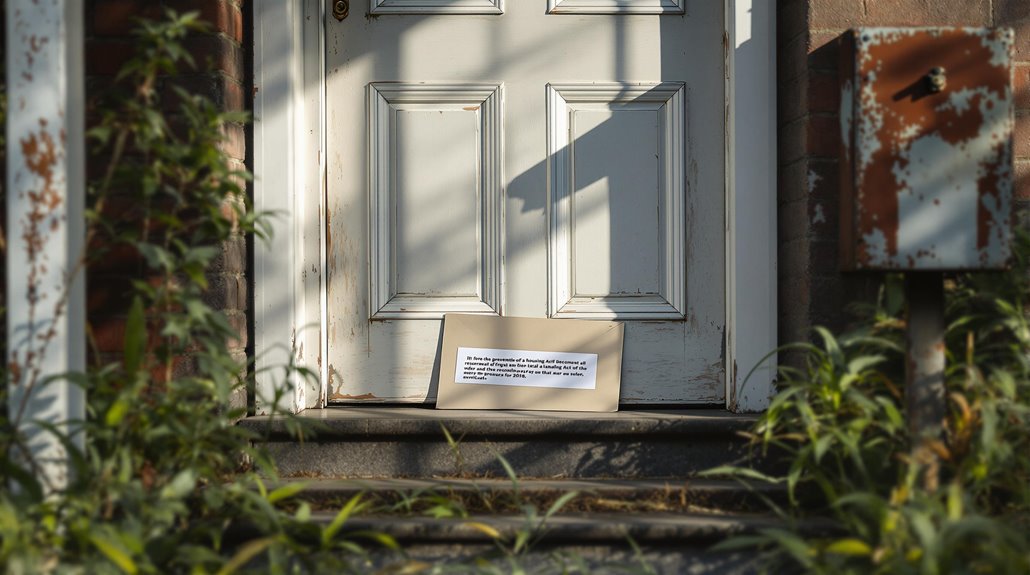I’ll walk you through the abandonment notice process that could save you months of lost rent and legal headaches when your tenant disappears without warning. While the Housing and Planning Act 2016 gives you powerful tools to reclaim your property, one misstep in documentation or timing can leave you facing unlawful eviction claims or extended vacancy periods. The difference between a smooth recovery and a costly legal nightmare often comes down to following the precise framework I’m about to outline.
Key Takeaways
- Only applies to assured shorthold tenancies in England with concrete evidence like unpaid rent, returned mail, and neighbor confirmations.
- First notice requires minimum 8-week response period; second notice allows 7-14 days before potential repossession proceedings.
- Must display notices prominently at property entrance and send tracked to all known tenant addresses with timestamped photo proof.
- Court order mandatory for physical repossession even after notices expire; changing locks or utilities invalidates the case entirely.
- Store abandoned belongings securely for 28 days minimum with full inventory documentation to avoid unlawful eviction claims.
Legal Framework for Property Abandonment Under the Housing and Planning Act 2016

When facing suspected property abandonment, you’ll need to navigate the specific legal framework established by Part 3 of the Housing and Planning Act 2016. This legislation specifically addresses recovery of abandoned premises, designed to help private landlords like you recover possession more easily without lengthy court proceedings.
The framework applies exclusively to assured shorthold tenancies in England and aims to increase rental property availability by speeding up repossession of genuinely abandoned properties. While true abandonment cases are rare—affecting only about 0.04% of private renting households—having this legal pathway available gives you a structured approach when it does occur.
The provisions work to reduce administrative burden on landlords by streamlining the recovery process compared to traditional court-based eviction procedures.
I’ll walk you through the essential conditions and procedures you must follow to successfully reclaim your property while staying compliant with the law.
Understanding Assured Shorthold Tenancies and Abandonment Rights
Before you can effectively use the Housing and Planning Act 2016‘s abandonment procedures, you must confirm your tenancy qualifies as an assured shorthold tenancy (AST). Most residential tenancies created after February 28, 1997, automatically become ASTs when rent falls between £250 and £100,000 annually.
I’ll help you understand your abandonment rights within this framework. As an AST landlord, you can’t simply assume abandonment because your tenant disappeared. You need concrete evidence—returned mail, utility disconnections, or neighbor statements confirming vacancy.
However, be aware that upcoming Renters Rights Act changes will transition most ASTs to assured tenancies, which may affect your abandonment procedures once implemented.
Building Your Case: Essential Evidence to Prove Tenant Abandonment

Although proving tenant abandonment might seem straightforward, you’ll need thorough documentation that meets legal standards before proceeding with the Housing and Planning Act 2016’s abandonment procedures.
I’ll walk you through the vital evidence categories that’ll strengthen your case. You’ll need clear financial documentation showing at least two consecutive months of rent arrears, backed by bank statements proving non-payment. Your tenancy agreement becomes significant here—especially any abandonment clauses you’ve included. Additionally, be aware that selling a property can incur hidden costs that might impact your financial situation during this process.
Physical evidence from the property matters too. Document the tenant’s extended absence, removal of personal belongings, and overall vacancy condition. Don’t forget to gather communication records showing your attempts to contact both the tenant and deposit payer. Watch for telltale signs like accumulation of mail from debt collectors, which strongly indicates the tenant has vacated permanently.
Finally, verify you’ve properly documented the tenancy deposit protection with all prescribed information readily available.
Documenting Unpaid Rent and Communication Breakdown
Your evidence collection extends beyond proving abandonment—you must meticulously document every missed payment and failed communication attempt. I’ll show you how to build an unshakeable case that courts will accept.
Start with a detailed rent ledger recording each due date, amount owed, and payment status. Calculate total arrears regularly and note any partial payments received. Your communication log becomes equally significant—document every phone call, email, and letter sent to your tenant. Include dates, times, and their responses or silence. Understanding your legal rights in these situations can further strengthen your position.
Issue formal written notices when rent falls behind, using trackable delivery methods like recorded post. Keep copies of everything: tenancy agreements, bank statements, and delivery confirmations. Remember that landlords must also maintain records of right to rent checks performed before the tenancy commenced, as these documents form part of your complete tenant file. This thorough documentation protects you legally and demonstrates you’ve followed proper procedures before taking action.
Mandatory Content Requirements for Abandonment Notices

While tenant abandonment might seem straightforward to identify, the law demands specific content in your abandonment notice to make it legally enforceable.
Your notice must clearly declare your belief that the property’s been abandoned, stating your rationale like unpaid rent or tenant unresponsiveness. You’ll need to demand a written response from the tenant, named occupier, or deposit payer, setting a deadline of at least 8 weeks after first issuance.
Include your contact details for tenant communication and specify consequences of non-response—that you’ll terminate the tenancy and reclaim possession. Don’t forget essential identifiers: full property address, tenant’s complete name, and your name and address as landlord.
Finally, warn that the tenancy ends without written response and confirm your notice follows Housing and Planning Act 2016 requirements. Professional legal compliance guidance ensures your abandonment notice meets all statutory requirements and protects you from potential disputes.
Proper Notice Delivery Methods and Legal Service Requirements
Creating a compliant abandonment notice means nothing if you can’t prove proper delivery to your tenant. I’ll show you exactly how to bulletproof your delivery process.
Inside the Property
Fix your notice prominently at the main entrance where it’s impossible to miss. Take timestamped photos as legal proof of placement. Never place notices outside where weather or removal becomes an issue.
Postal Delivery
Send tracked copies to every UK address your tenant provided during the tenancy agreement. Include guarantors and named occupiers. Keep all postage receipts.
Electronic Contact
Email every address you have on file. Archive messages with read receipts when possible.
Critical Legal Protection
Stop everything if your tenant responds within four weeks. Only court orders guarantee legal immunity from unlawful eviction charges. Remember that rent remains owed until either the tenancy period ends or you successfully re-let the property to new tenants.
Timeline Management: First Notice Through Final Repossession

Once you’ve mastered proper notice delivery, understanding the complete eviction timeline becomes your next critical step toward successful property reclamation. You’re looking at an average 25.4 weeks from initial court claim to final repossession in 2024—that’s nearly six months of your property being tied up. It’s essential to remember that managing estate agent fees can also impact your overall financial strategy when reclaiming property.
Here’s what you’ll face: After your Section 21 notice expires, court claims take 8.1 weeks to reach hearing. If you win, possession orders give tenants 14-28 days to vacate. When they don’t comply, warrant applications add another 6 weeks before bailiffs can act.
I’ll be straight with you—these timelines have worsened. We’re seeing 15% longer processes than 2023 due to court backlogs. Most tenants actually vacate voluntarily before reaching the final warrant stage, which means many cases don’t progress through all four stages of the possession process. Plan accordingly and maintain detailed records throughout.
The Two-Notice Process and Waiting Periods Explained
When you suspect a tenant has abandoned your property, you can’t simply change the locks and move on—the law requires a structured two-notice process that protects both parties while establishing your legal position.
Your first notice gives tenants four weeks to respond and prove they’re still occupying the property. Display it prominently inside and send copies to all known addresses. If they don’t respond within this timeframe, you’ll issue a second notice with a much shorter deadline—typically 7-14 days.
This second notice makes your repossession intentions crystal clear and serves as final warning before court proceedings. The landlord must attempt to contact tenant during the four-week period following the initial warning notice. Remember, even after both notices expire, you still can’t physically reclaim the property without a court order. These notices build your evidence trail but don’t replace proper legal channels.
Post-Abandonment Property Recovery and Tenant Belongings

After you’ve successfully navigated the notice period and confirmed abandonment, you’ll face two critical tasks: legally reclaiming your property and dealing with whatever belongings the tenant left behind.
First, I’ll inventory everything left behind, documenting each item’s condition and value. This protects you from later disputes about disposal. You must store belongings securely for at least 28 days – this isn’t optional under the Torts Act. Additionally, it’s wise to consult with affordable conveyancing solicitors to ensure compliance with legal obligations throughout the process.
Send written notice to the tenant‘s last known address about your disposal intentions. For high-value items like electronics or vehicles, sell them through public auction to offset unpaid rent. Low-value items can be donated or discarded if storage costs exceed recovery potential. If you successfully locate ex-tenants, you can pursue further debt recovery through bailiffs or high court enforcement officers for any remaining unpaid amounts.
Always retain proof of your valuation efforts and disposal methods for potential court proceedings.
Protecting Yourself From Unlawful Eviction Claims and Legal Risks
Beyond handling abandoned belongings, you’ll face potentially devastating legal consequences if you don’t execute the eviction process correctly. I can’t stress enough how critical proper documentation becomes when defending against unlawful eviction claims.
You must serve valid Section 21 or Section 8 notices with accurate dates and tenant details. Never change locks yourself – only court bailiffs can legally remove tenants. Cutting utilities or making threats will invalidate your case entirely. Additionally, having landlord insurance can provide you with essential financial protection against unexpected legal issues.
Keep meticulous records of all communications and rent payments. These documents become your shield against compensation claims and Rent Repayment Orders that could cost you 12 months of rent. If tenants suffer from your harassment or illegal eviction, they can pursue damages through court to recover their losses.
Consider landlord insurance for legal defense costs, and consult solicitors before taking action. We’re in this together, and following proper procedures protects your investment.
Conclusion
I’ve walked you through every critical step of the abandonment notice process—from gathering evidence to final property recovery. You now understand the legal framework, documentation requirements, and timeline management essential for successful property reclamation. Don’t skip any steps or rush the process. Follow the two-notice system precisely, maintain detailed records, and handle tenant belongings correctly. This methodical approach protects you from costly legal challenges while efficiently reclaiming your property.
References
- https://www.totallandlordinsurance.co.uk/knowledge-centre/ultimate-landlords-guide-to-abandonment-notices
- https://www.alanboswell.com/resources/notice-of-abandonment/
- https://nolettinggo.co.uk/blog/what-is-notice-of-abandonment/
- https://www.citizensadvice.org.uk/wales/housing/eviction/getting-evicted/renting-from-the-council-or-housing-association/if-youre-being-evicted-for-abandoning-your-home-w/
- https://www.cia-landlords.co.uk/advice/notice-of-abandonment/
- https://www.lexisnexis.co.uk/legal/guidance/housing-planning-act-2016-recovering-possession-of-abandoned-premises
- https://www.legislation.gov.uk/ukpga/2016/22/part/3
- https://landlordsdefence.co.uk/recovering-abandoned-premises-dramatic-legal-changes/
- https://www.solegal.co.uk/insights/abandoned-properties-clarity-landlords
- https://cornerstonebarristers.com/wp-content/uploads/old/abandoned-premises.pdf

